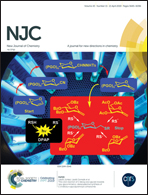New 2D–π–2A organic dyes with bipyridine anchoring groups for DSSCs†
Abstract
Anchoring groups play an important role in the structure of dyes by determining the charge injection efficiency and the bonding degree between the sensitizer and the semiconductor surface. In this work, two new 2D–π–2A-type metal-free organic dyes S1 and S2 with bipyridine anchoring groups were synthesized and applied in dye-sensitized solar cells (DSSCs). The IR spectra indicated that the two dyes could anchor on the Lewis acid sites of the TiO2 surface through the bipyridine anchoring group, and the bidentate configuration was conducive for improving the electron injection efficiency and enhancing the dye adsorption stability. In addition, since phenothiazine and carbazole are often used as electron donors in DSSCs, in this work, we also compared their different effects on the photoelectric properties in detail. The DSSC based on S1 showed PCE of 4.39% under AM 1.5G irradiation and Voc of 708 mV, Jsc of 9.39 mA cm−2, and FF of 65.99%, while the DSSC based on S2 showed PCE of 2.96%; the main reason for these results is that their Voc and Jsc values were very different. We also studied the dye loading amounts, optical properties, electrochemical properties, and photovoltaic performances to analyze the differences between the two devices.



 Please wait while we load your content...
Please wait while we load your content...